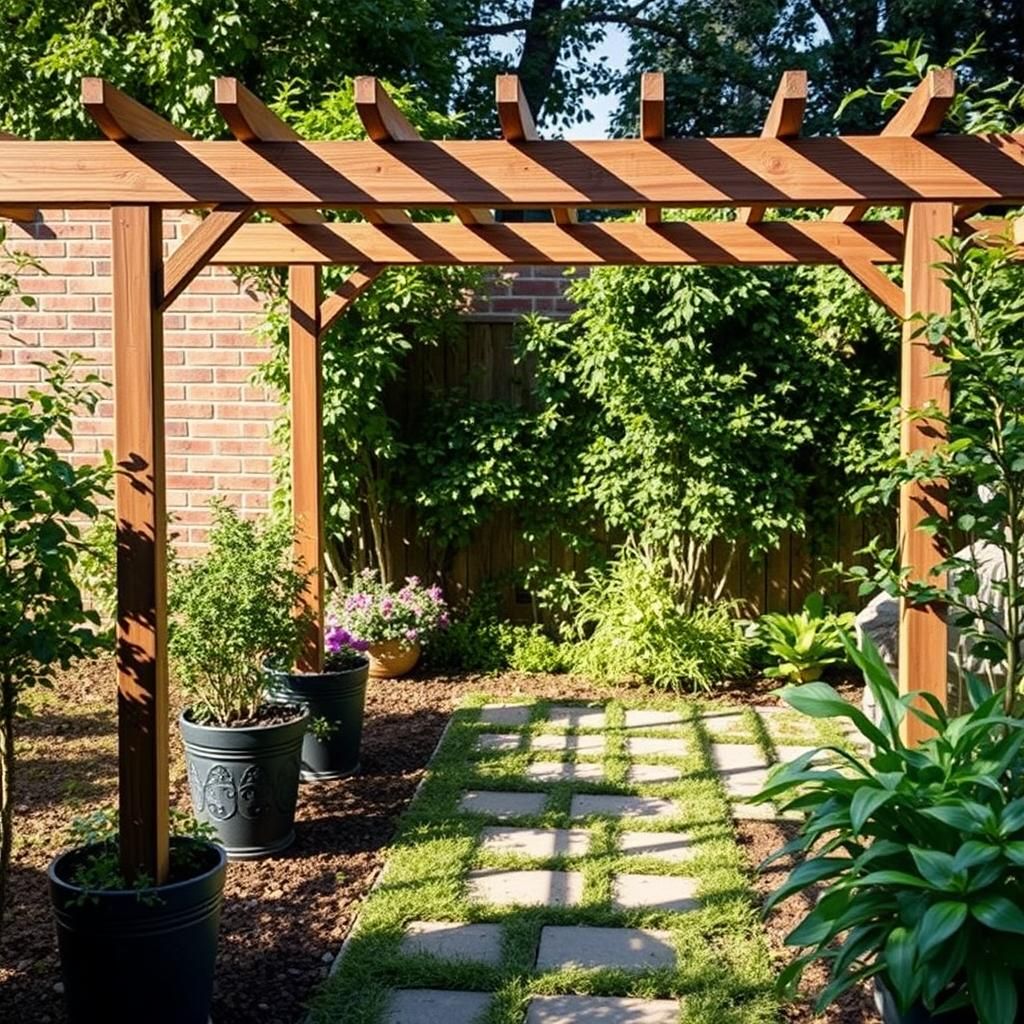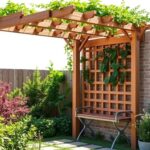Can a Trellis Be Free Standing? Exploring the Benefits and Design Ideas

When it comes to enhancing outdoor spaces, trellises are often celebrated for their versatility and aesthetic appeal. But can a trellis truly be free standing? This article delves into the concept of free-standing trellises, exploring their benefits in terms of design flexibility and functionality. We’ll examine various design ideas that allow these structures to stand independently while providing support for climbing plants and adding visual interest to gardens, patios, or balconies. Whether you’re a gardening enthusiast or simply looking to elevate your landscape design, understanding the potential of free-standing trellises can inspire your next outdoor project.
Can a Trellis Be Free Standing?
A freestanding trellis can definitely be designed and constructed, providing a unique appeal to gardens and outdoor spaces. To be considered freestanding, the trellis must be self-supporting, without the need for additional structures or supports, such as walls or fences. This setup allows for greater flexibility in placement, enabling gardeners to position the trellis wherever they desire, which is particularly helpful for varieties of climbing plants that may need extra support for growth. The construction of a freestanding trellis typically involves robust materials such as wood, metal, or composite materials, ensuring stability against wind and the weight of the plants. Overall, a well-constructed freestanding trellis not only serves the practical purpose of supporting climbing plants but also enhances the aesthetic value of the garden.
Types of Freestanding Trellises
Freestanding trellises can come in various forms, each designed for different plant types and garden aesthetics. Popular types include arch trellises that create an elegant entryway for climbing plants like roses, panel trellises that provide a flat climbing surface for vegetables and flowers, and lattice trellises which feature crisscross patterns, giving plants various surfaces to latch onto. The choice of type is dictated not only by the plants being supported but also by the overall design of the landscape. In addition to appearance, each type varies in construction and stability requirements, making it essential for gardeners to select the appropriate option based on their specific needs.
Materials for Freestanding Trellises
When building a freestanding trellis, the choice of materials is crucial for ensuring both durability and aesthetic appeal. Common materials include wood, which tends to blend naturally into garden environments but requires treatment against rot; metal, which offers durability and a modern look, especially useful for heavier climbing plants; and composite materials, which are resistant to weathering and require less maintenance. Each material has its pros and cons; for example, while wooden trellises may offer a classic charm, metal structures can withstand harsher weather conditions. Choosing the right material ultimately depends on factors such as budget, desired longevity, and garden style.
Design Considerations
Several design considerations must be taken into account when constructing a freestanding trellis. The height and width should be proportionate to both the space available in the garden and the specific plants intended for training. Adequate footing is necessary for balance, especially in windy areas, which may require digging deeper post holes or using anchoring weights. Additionally, aesthetic factors should align with the overall theme of the garden—such as color, shape, and ornamental features. Proper spacing between the lattice or panel sections is also critical, as it ensures that the plants receive adequate sunlight and air circulation, promoting healthy growth.
Installation Tips for Freestanding Trellises
Proper installation is vital for the success and longevity of a freestanding trellis. First, consider the ideal site for placement, ensuring that it receives the right amount of sunlight and is not obstructed by nearby plants or structures. Additionally, securing the trellis in the ground is crucial; use concrete or gravel to stabilize wooden posts, ensuring they don't shift over time. Properly anchoring the trellis before planting climbing vegetation will allow the plants to establish themselves and grow without the risk of the trellis collapsing. Regularly checking the structural integrity of the installation is recommended, especially after storms or heavy winds.
Benefits of Freestanding Trellises
Freestanding trellises offer numerous benefits that enhance garden functionality and beauty. They allow for more planting options, as gardeners can position them in various locations, optimizing sunlight and creating diverse garden layers. These structures can dramatically improve plant health by providing vertical space for climbing plants, reducing the risk of pests and diseases that often occur when plants grow too close to the ground. Moreover, well-placed trellises can serve as privacy screens, windbreaks, or architectural focal points within the landscape, adding depth and character to outdoor spaces.
| Aspect | Details |
|---|---|
| Type | Arch, Panel, Lattice |
| Material | Wood, Metal, Composite |
| Height | Should match plant type and garden space |
| Installation | Secure underground, optimal sunlight placement |
| Benefits | Space optimization, plant health, aesthetics |
Advantages of Freestanding Trellis Structures in Garden Design
Utilizing a freestanding trellis in your garden offers multiple advantages, including increased versatility and the ability to create striking vertical elements without the constraints of existing walls or structures. This standalone option allows gardeners to manipulate sunlight exposure, create intimate spaces, or establish defined pathways within the garden. Additionally, a freestanding trellis can also support a variety of climbing plants, enhancing the aesthetic appeal of your outdoor space while improving air circulation and plant health. By selecting the right materials and designs, a freestanding trellis can serve as both a functional and decorative piece that elevates your overall garden layout.
See also:
Design Considerations for Freestanding Trellises
When planning a freestanding trellis, several design considerations are essential for ensuring the structure meets your aesthetic and functional needs. Materials such as wood, metal, or vinyl can significantly impact the visual appeal and durability of the design. It's crucial to consider the scale of the trellis in relation to surrounding plants and furniture, as well as how the trellis will withstand weather elements like wind and rain. Proper anchoring is also important to maintain stability, especially for larger structures. Ultimately, a thoughtful approach to these design elements will contribute to a successful and attractive addition to any garden.
Popular Plants for Freestanding Trellises
A variety of climbing plants thrive when supported by a freestanding trellis, allowing for a vibrant display of colors and textures in your garden. Popular choices include vines like clematis, jasmine, and sweet pea, which offer lush foliage and fragrant blooms. Additionally, many gardeners opt for fruit-bearing vines such as grapes or kiwi, which not only beautify the landscape but also provide delicious yields. When selecting plants, it’s important to consider their growth habits and sunlight requirements to ensure compatibility with the trellis structure and overall garden conditions, maximizing their potential
Construction Tips for Stability and Durability
To build a durable and stable freestanding trellis, careful attention must go into the construction process. Begin by selecting sturdy materials designed to withstand outdoor conditions, such as pressure-treated wood or galvanized steel. Utilize appropriate fasteners and brackets to securely connect each component, maintaining the integrity of the structure under stress. Additionally, incorporating a concrete footing or anchor can significantly enhance stability, especially for taller trellis designs. Regular maintenance checks, including inspecting for rot or rust, will help preserve the trellis’s longevity, ensuring it remains a focal point in the garden for many seasons.
Creative Uses for Freestanding Trellises in Landscaping
Freestanding trellises can serve multiple creative purposes in landscaping beyond merely supporting climbing plants. They can act as privacy screens, creating secluded areas for relaxation within an outdoor space. Another innovative use is incorporating them into pathways or entrances, guiding visitors while enhancing the overall experience. Additionally, trellises may function as artistic backdrops for outdoor gatherings or events, making a statement while complementing the surrounding environment. By tapping into their versatility, gardeners can elevate the functionality of their outdoor spaces significantly.
Maintenance of Freestanding Trellises
Maintaining a freestanding trellis is crucial to ensure its structural integrity and aesthetic appeal over time. Regular checks for any signs of damage, such as splintering wood or rusting metal, allow for timely repairs that prevent further deterioration. Additionally, it's important to assess the health of the climbing plants attached to the trellis, which may require periodic pruning and support adjustments. Keeping the area around the trellis clear of debris and weeds also promotes a clean appearance and reduces pest issues. By dedicating time to maintenance, gardeners can enjoy a vibrant and functional trellis season after season.
Questions from Our Readers
Can a trellis be free standing?
Yes, a trellis can definitely be free standing. This type of trellis is designed to support climbing plants without needing to be attached to a wall or fence. Using sturdy materials and proper construction techniques will help ensure its stability.
What materials are best for a free standing trellis?
The best materials for a free standing trellis include wood, metal, and strong plastic. Each material has its own advantages; for instance, wood can provide a natural look, while metal offers durability and resistance to the elements.
How tall should a free standing trellis be?
The height of a free standing trellis largely depends on the type of plants you intend to grow. Generally, it should be at least 5 to 7 feet tall for most climbing plants, allowing for proper growth and support.
See also:
How do I secure a free standing trellis?
To secure a free standing trellis, it's important to ensure it has a solid base. You can use stakes to anchor it into the ground or weight it down with heavy planters or stone. This adds extra stability and prevents it from toppling over in strong winds.

If you want to read more articles like Can a Trellis Be Free Standing? Exploring the Benefits and Design Ideas, we recommend you check out our Trellis category.
Leave a Reply
Related Articles